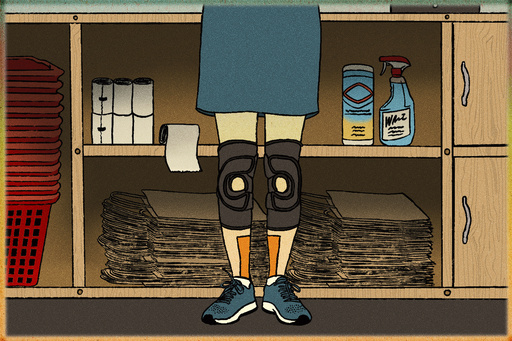NEW YORK — Margaux Lantelme, who holds dual citizenship in France and the United States, has observed a distinct contrast in the practices of cashiers in the two nations. In France, cashiers generally perform their tasks while seated. Conversely, in the U.S., where Lantelme operates a register at REI, cashiers typically endure long hours standing on their feet.
Having previously worked as a kayaking instructor, Lantelme finds that standing for extended periods exacerbates her chronic pain, which affects her mobility. To address this issue, she requested a chair for her shifts and initially received one. However, after a management change, she was required to go through a lengthy approval process, which entailed multiple doctor visits and insurance co-payments over several months. At present, she waits for the final nod on this matter.
“Not being able to access a chair without going through an approval process that drains my time, energy, and finances feels absurd,” Lantelme remarked. “I strongly believe that employees should have the right to use seating whenever they require it.”
The impact of prolonged standing on health can be quite significant. Research from the National Institute for Occupational Safety and Health indicates that spending long periods on one’s feet can lead to various ailments, including lower back pain, fatigue, muscle discomfort, and swelling in the legs. This condition can also escalate the risk of cardiovascular issues and complications during pregnancy. Experts suggest that moving about—whether by walking or alternating between standing and sitting—can effectively mitigate these health risks.
Standing for long durations may also contribute to chronic venous insufficiency, a health condition whereby damaged veins diminish blood circulation, as stated by the Association of periOperative Registered Nurses, a body representing surgical nurses. Certain strategies, such as propping one foot on a stool, using anti-fatigue mats, and wearing supportive footwear, are recommended to reduce fatigue.
Numerous occupations necessitate standing for extended times, including roles such as department store sales associates, hairstylists, surgeons, restaurant cooks, and airport staff. Cecilia Ortiz, a former airport wheelchair attendant in Phoenix, found her previous job taxing on her knees. In her old workplace, there were only a few chairs available in the break room, compelling employees to sit on the floor in hallways at times.
Ortiz recalled receiving a reprimand from her supervisor for taking a quick break at a charging station following five hours of continuous work on her feet. She is now employed at a distribution warehouse for the airport, where taking a seat when needed is more permissible. “There’s much more flexibility now; sitting down whenever required is not an issue,” Ortiz mentioned.
Growth in employee rights is also visible in labor negotiations. Unionized workers at the Barnes & Noble location in Manhattan’s Union Square have pushed for the right to sit down under certain circumstances as they work towards their first contract. Bear Spiegel, a 28-year-old bookseller, expressed his concerns about developing knee pain due to the physical demands of shelving books and attending to customers. He believes having a stool readily available would greatly aid in managing his discomfort throughout the day.
While Spiegel has occasionally been permitted to use a stool during his shifts, he also noted that his colleagues resorted to using knee braces and athletic tape for relief. Each day brings unpredictability regarding his symptoms, making it hard for him to determine when he might need extra support. However, his managers have usually been accommodating.
Barnes & Noble is mentioned to have a policy where chairs or stools can be used by staff not actively working on the sales floor. Yet, a significant portion of a bookseller’s responsibilities involves moving around—unpacking, sorting, and shelving items, according to a company representative.
In a broader labor movement context, the Retail, Wholesale, and Department Store Union, which represents around 100,000 workers, is advocating for a guaranteed right to sit during work tasks that can be performed while seated. Stuart Appelbaum, the union’s president, recounted a moment during negotiations when an employer opposed this request. To illustrate their stance, union negotiators removed all chairs from the conference room table during a break, which made the point starkly clear. Ultimately, they succeeded in including the request for chairs in their contract.
Historically, the right to sit has seen various regulations. Around the early 1900s, many states had laws that mandated seating for female workers, driven by the influx of women into the workforce and concerns over their physical wellbeing. Eileen Boris, a labor historian and professor, detailed how these laws aimed to protect women, seen as key figures in motherhood. However, as calls for gender equality grew, such laws were gradually repealed.
Internationally, labor movements have fared better in securing seating rights. For instance, in 1964, the International Labour Organization established guidelines that required employers to provide adequate seating and allow workers to utilize them. Although over 50 countries ratified this agreement, the United States did not.
Presently, states like California, Florida, Massachusetts, and others have enacted “right to sit” legislation compelling employers to offer appropriate seating for their workforce, irrespective of gender. Recently, Ann Arbor, Michigan, has followed suit, mandating that various businesses allow their employees to sit, as long as their duties are not hindered by doing so. A statewide bill in Michigan has also been introduced to address this issue.
In closing, the discussion around workers’ rights, including issues of seating, continues to evolve, reflecting broader social changes and the quest for equitable working conditions.




